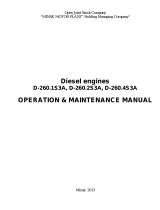
G-7
V3-E3B SERIES, V3-E3CB SERIES, V3-E3BG SERIES, WSM
G GENERAL
Q NOTE
Engine Oil :
• Refer to the following table for the suitable American Petroleum Institute (API) classification of engine oil
according to the engine type (with internal EGR, external EGR or non-EGR) and the Fuel Type Used :
(Low Sulfur, Ultra Low Sulfur or High Sulfur Fuels).
EGR : Exhaust Gas Re-circulation
W1024941
• CJ4 classification oil is intended for use in engines equipped with DPF (Diesel Particulate Filter) and is Not
Recommended for use in Kubota E3 specification engines.
• Oil used in the engine should have API classification and Proper SAE Engine Oil Viscosity according to
the ambient temperatures where the engine is operated.
• With strict emission control regulations now in effect, the CF-4 and CG-4 engine oils have been developed
for use with low sulfur fuels, for On-Highway vehicle engines. When a Non-Road engine runs on high
sulfur fuel, it is advisable to use a "CF or better" classification engine oil with a high Total Base Number
(a minimum TBN of 10 is recommended).
Fuel :
• Cetane Rating : The minimum recommended Fuel Cetane Rating is 45. A cetane rating greater than 50 is
preferred, especially for ambient temperatures below −20 °C (−4 °F) or elevations above 1500 m (5000 ft).
• Diesel Fuel Specification Type and Sulfur Content % (ppm) used, must be compliant with all applicable
emission regulations for the area in which the engine is operated.
• Use of diesel fuel with sulfur content less than 0.10 % (1000 ppm) is strongly recommended.
• If high-sulfur fuel (sulfur content 0.50 % (5000 ppm) to 1.0 % (10000 ppm)) is used as a diesel fuel, change
the engine oil and oil filter at shorter intervals. (approximately half)
• DO NOT USE Fuels that have sulfur content greater than 1.0 % (10000 ppm).
• Diesel fuels specified to EN 590 or ASTM D975 are recommended.
• No.2-D is a distillate fuel of lower volatility for engines in industrial and heavy mobile service. (SAE J313
JUN87)
• Since KUBOTA diesel engines of less than 56 kW (75 hp) utilize EPA Tier 4 and Interim Tier 4 standards,
the use of low sulfur fuel or ultra low sulfur fuel is mandatory for these engines, when operated in US EPA
regulated areas. Therefore, please use No.2-D S500 or S15 diesel fuel as an alternative to No.2-D, and use
No.1-D S500 or S15 diesel fuel as an alternative to No.1-D for ambient temperatures below −10 °C (14 °F).
1) SAE : Society of Automotive Engineers
2) EN : European Norm
3) ASTM : American Society of Testing and Materials
4) US EPA : United States Environmental Protection Agency
5) No.1-D or No.2-D, S500 : Low Sulfur Diesel (LSD) less than 500 ppm or 0.05 wt.%
No.1-D or No.2-D, S15 : Ultra Low Sulfur Diesel (ULSD) 15 ppm or 0.0015 wt.%
Fuel Type
Engine oil classification (API classification)
Engines with non-EGR
Engines with internal EGR
Engines with external EGR
High Sulfur Fuel
[0.05 % (500 ppm) ≤
Sulfur Content <
0.50 % (5000 ppm)]
CF
(If the "CF-4, CG-4, CH-4, or CI-4" engine
oil is used with a high-sulfur fuel, change
the engine oil at shorter intervals.
(approximately half))
–
Low Sulfur Fuel
[Sulfur Content <
0.05 % (500 ppm)] or
Ultra Low Sulfur Fuel
[Sulfur Content <
0.0015 % (15 ppm)]
CF, CF-4, CG-4, CH-4 or CI-4
CF or CI-4
(Class CF-4, CG-4 and CH-4 engine oils
cannot be used on EGR type engines.)





















